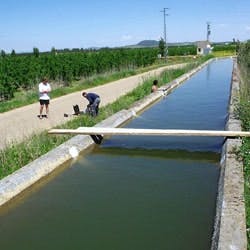Accurate, Continuous Flow Measurement Ensures Efficient Use of Irrigation Water
It is estimated that Spain has approximately 40,000 Hm3/year of available water. This amount is usually sufficient, however, serious water shortages sometimes can occur with irregular weather patterns and contrasting geographical areas. For example, the Southern and Central Mediterranean river basins represent 41% of Spanish territory and accommodate 37% of the population, but people in these areas only benefit from 19% of the total water resources.
In Spain, irrigation increases productivity six-fold and profitability four-fold. As a result, irrigation is a fundamental activity within Spanish agriculture. Spain now has a total irrigated surface of 8.4 million acres. This generates 1.2% of the country’s Gross National Product.
The National Irrigation Plan is set to be more than a catalog of works and seeks to give priority for funding to areas in need of rural regeneration or for the protection of natural resources. The main drivers for the irrigation plan are:
- An increased social environmental responsibility; in Spain 80% of water consumption is used for irrigation, so environmental protection is linked with the efficient handling of irrigation water.
- Increased competition in the world market; modernizing to increase efficiency in the use of water and reduce energy and operating costs.
- European Water Directive 2000 and European Agricultural Policies.
- The implementation of regional rural social development policies.
One of the projects of the National Irrigation Plan covers the Orellana Irrigation District in the southwest of Spain. It is a sunny, dry region where the main economic activity is agriculture. Original construction of the irrigation infrastructure occurred in the 1960s.
The main objective of the project is to reduce total water consumption by one third. However, in order to make improvements it is necessary to monitor flow rates in the Orellana Canals both before and after renovation work to the infrastructure. A flow-monitoring network of 55 measurement points has been installed. The flow data also will help in analyzing efficiency of water use, both overall and within individual sectors.
In April 2004, before the start of the irrigation season, 30 SonTek/YSI acoustic Doppler instruments were installed to precisely monitor flow in shallow irrigation channels less than three meters deep. Twenty-five additional instruments were installed in April 2005. (This work was completed in conjunction with Qualitas Instruments, S.A., a SonTek partner.)
At present, water is charged on the basis of land area ownership; however, this does not encourage efficient use of water. So, the continuous, accurate measurement of flow will facilitate charging for water on the basis of consumption. The principle involved is much the same as with domestic water meters – householders that are charged according to their water usage tend to be more efficient users of water than those who are not.
The operators of the system in Orellana have reported that the SonTek/YSI Argonaut-SW flowmeters were simple and quick to install and that data retrieval is easy. Very little maintenance is required, other than a ‘face wash’ for the sensors once per season to remove algae.
The main objective of the flow measurement solution in Orellana was to measure volume and flow with a high and constant quality of the data. This means reliably measuring everywhere, at every channel, and every time, not conditioned by the quantity or the quality of the water. In addition to this, a solution which provided the lowest total cost of ownership was important.
After one irrigation season, those involved in the project agreed that selecting the SonTek/YSI instruments was the right choice. Therefore, the stumbling blocks to achieving the district’s water efficiency objective are not likely to be a result of the monitoring technology or data, but are more likely to take the form of political issues. One of the main obstacles for Spain is creating consensus among governments and organizations that have become accustomed to a water situation that has existed for many years.
Following the selection of the SonTek/YSI Argonaut-SW as the Best New Product at the 2003 International Irrigation Show, the Orellana contract is a major step in the worldwide acceptance of the Argonaut’s advanced acoustic Doppler technology in the agricultural industry.
